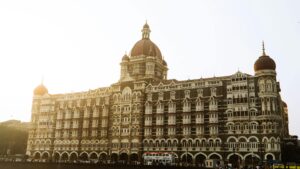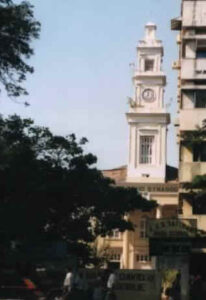Mumbai
Mumbai (or Bombay, as recently known) is the commercial capital of India – India’s New York City.
Our city tour will include The Gateway of India, Mumbai’s principal landmark, the arch of yellow basalt which was erected on the waterfront in 1924 to commemorate King George V’s visit to this colony in 1911; Afghan Church built in memory of those who fell in the First Afghan War; The Gothic style Bombay High Court; Ornamental university building with its 280 ft. high Rajabhai Clock Tower; the ornate Victoria Terminus; colorful Crawford Market; Flora Fountain in the large bustling square at the heart of the city; the Prince of Wales Museum which houses a varied collection of China-ware, miniature paintings and sculptures; Marine Drive which is known as the Queen’s Necklace. The unusual shrine to Haji Ali, a Muslim Saint which stands on an island 500m out at sea and is linked by a causeway to the mainland. Malabar Hill with the Kamla Nehru Park; the Hanging Gardens offering a splendid view of the city; the Malaxmi and Jain Temples; Mani Bhavan where Mahatma Gandhi stayed during his visits to Bombay; and, the Taraporewalla Aquarium.
Mahatma Gandhi started his law practice in 1892. In Jan 1918, he started the Sathyagragh here.
 The cosmopolitan and multi-racial population in the city of Bombay includes about 5,000 Jews. Half of them are Bene-Israel (or son of Israel) and the other half are “Bagdadi” Jews (or Jews from Baghdad, Syria). The important synagogues include the Gate of Mercy Synagogue or the Shaar Ha-Rahamim (Gate of Mercy in Hebrew) which celebrated its bi-centennial in 1996; the Ohel David Synagogue; and the Knesseth Eliahod Synagogue popularly known as the Fort Jewish Synagogue.
The cosmopolitan and multi-racial population in the city of Bombay includes about 5,000 Jews. Half of them are Bene-Israel (or son of Israel) and the other half are “Bagdadi” Jews (or Jews from Baghdad, Syria). The important synagogues include the Gate of Mercy Synagogue or the Shaar Ha-Rahamim (Gate of Mercy in Hebrew) which celebrated its bi-centennial in 1996; the Ohel David Synagogue; and the Knesseth Eliahod Synagogue popularly known as the Fort Jewish Synagogue.
Elephanta Caves: The island of Elephanta is just an hour away from Bombay by motor launch. The cave temples here, excavated between the 5th and 8th centuries AD, are famous for their magnificently sculpted panels. The best known is one that depicts the Maheshmurti – a three-headed image of Lord Shiva. This island was so named by the Portuguese after the large stone elephant near the landing place and which now stands at the Victoria and Albert Museum in Mumbai. The caves are reached by a stairway up the hillside from the ferry landing.
